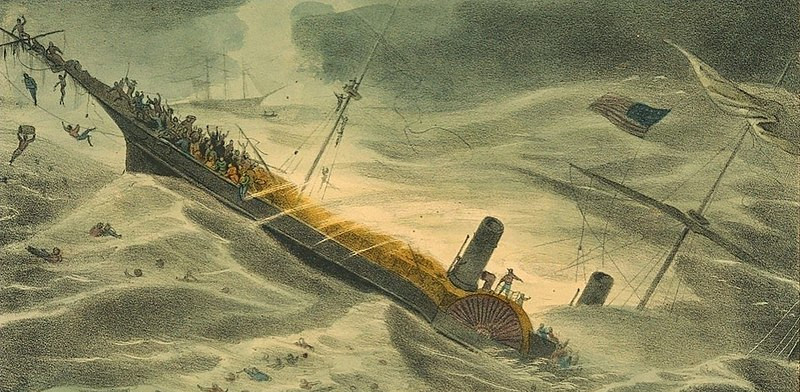“Tradition means giving votes to the most obscure of all classes — our ancestors. It is the democracy of the dead. Tradition refuses to submit to the small and arrogant oligarchy of those who merely happen to be walking around.” — G.K. Chesterton
Society
A Pirate’s Credo
Cruising off Rhode Island in 1717, pirate Samuel Bellamy plundered a Boston sloop and granted his crew’s wish to sink her. Before putting the captain ashore, Bellamy told him:
I am sorry they won’t let you have your sloop again, for I scorn to do any one a mischief, when it is not to my advantage; damn the sloop, we must sink her, and she might be of use to you. Though you are a sneaking puppy, and so are all those who will submit to be governed by laws which rich men have made for their own security; for the cowardly whelps have not the courage otherwise to defend what they get by knavery; but damn ye altogether: damn them for a pack of crafty rascals, and you, who serve them, for a parcel of hen-hearted numbskulls. They vilify us, the scoundrels do, when there is only this difference, they rob the poor under the cover of law, forsooth, and we plunder the rich under the protection of our own courage. Had you not better make then one of us, than sneak after these villains for employment?
The captain replied that his conscience forbade him to break the laws of God or man. Bellamy returned, “You are a devilish conscience rascal! I am a free prince, and I have as much authority to make war on the whole world as he who has a hundred sail of ships at sea and an army of 100,000 men in the field; and this my conscience tells me! But there is no arguing with such snivelling puppies, who allow superiors to kick them about deck at pleasure.”
(From Charles Johnson, A General History of the Robberies and Murders of the Most Notorious Pyrates, 1724.)
A Lesson
John Alexander Smith, Waynflete Professor of Moral and Metaphysical Philosophy at Oxford, opened a course of lectures in 1914 with these words:
“Gentlemen — you are now about to embark upon a course of studies which will occupy you for two years. Together, they form a noble adventure. But I would like to remind you of an important point. Some of you, when you go down from the University, will go into the Church, or to the Bar, or to the House of Commons, to the Home Civil Service, to the Indian and Colonial Services, or into various professions. Some may go into the Army, some into industry and commerce; some may become country gentlemen. A few — I hope a very few — will become teachers or dons. Let me make this clear to you. Except for the last category, nothing that you will learn in the course of your studies will be of the slightest possible use to you in after life — save only this — that if you work hard and intelligently you should be able to detect when a man is talking rot, and that, in my view, is the main, if not the sole, purpose of education.”
Coghill’s Law
With Love and with Lust, I often have reckoned,
Whichever comes first soon turns into the second.
(By Oxford English professor Nevill Coghill, 1899-1980.)
Being There
The 1937 phrasebook Collins’ Pocket Interpreters: France paints an alarming picture of a typical visit to France:
I cannot open my case.
I have lost my keys.
I did not know that I had to pay.
I cannot find my porter.
Excuse me, sir, that seat is mine.
I cannot find my ticket!
I have left my gloves (my purse) in the dining car.
I feel sick.
The noise is terrible.
Did you not get my letter?
I cannot sleep at night, there is so much noise.
There are no towels here.
The sheets on this bed are damp.
I have seen a mouse in the room.
These shoes are not mine.
The radiator doesn’t work.
This is not clean, bring me another.
I can’t eat this. Take it away!
The water is too hot, you are scalding me!
It doesn’t work.
This doesn’t smell very nice.
There is a mistake in the bill.
I am lost.
Someone robbed me.
I shall call a policeman.
That man is following me everywhere.
There has been an accident!
She has been run over.
He is losing blood.
He has lost consciousness.
James Thurber, who came upon the book in a London bookshop, described it as a “melancholy narrative poem” and “a dramatic tragedy of an overwhelming and original kind.” “I have come across a number of these helps-for-travelers,” he wrote, “but none has the heavy impact, the dark, cumulative power of Collins’. … The volume contains three times as many expressions to use when one is in trouble as when everything is going all right.”
I can’t find the 1937 edition that Thurber describes, but this seems to be a 1962 update.
Loaded

“Lately in a wreck of a Californian ship, one of the passengers fastened a belt about him with two hundred pounds of gold in it, with which he was found afterwards at the bottom. Now, as he was sinking — had he the gold? or had the gold him?”
— John Ruskin, Unto This Last, 1860
Lost Lessons
THOUGH I can never pay enough to your Grandfather’s Memory, for his tender care of my Education, yet I must observe in it this Mistake; That by keeping me at home, where I was one of my young Masters, I lost the advantage of my most docile time. For not undergoing the same Discipline, I must needs come short of their experience, that are bred up in Free Schools; who, by plotting to rob an Orchard, &c. run through all the Subtilties required in taking of a Town; being made, by use, familiar to Secresie, and Compliance with Opportunity; Qualities never after to be attained at cheaper rates than the hazard of all: whereas these see the danger of trusting others, and the Rocks they fall upon, by a too obstinate adhering to their own imprudent resolutions; and all this under no higher penalty than a Whipping: And ’tis possible this indulgence of my Father might be the cause I afforded him so poor a Return for all his Cost.
— Francis Osborne, Advice to a Son, 1656
Noted
Henry George Liddell and Robert Scott’s Intermediate Greek-English Lexicon of 1851 contains a sobering entry:
ραφανιδοω: to thrust a radish up the fundament, a punishment of adulterers in Athens
In recalling this to friends at Christmas in 1972, historian John Julius Norwich wrote, “I’m sure it must once have been familiar to every schoolboy, and now that the classics are less popular than they used to be I should hate it to be forgotten.”
Worldly Wise

Proverbs from around the world:
- Don’t buy someone else’s problems. (Chinese)
- Strange smoke irritates the eyes. (Lithuanian)
- The poor lack much, but the greedy more. (Swiss)
- It is the mind that wins or loses. (Nepalese)
- The point of the needle must pass first. (Ethiopian)
- God did not create hurry. (Finnish)
- When you go, the road is rough; when you return, smooth. (Thai)
- If you want to marry wisely, marry your equal. (Spanish)
- Where is there a tree not shaken by the wind? (Armenian)
- Wherever you go, you can’t get rid of yourself. (Polish)
- Money swore an oath that nobody that did not love it should ever have it. (Irish)
- Character is habit long continued. (Greek)
- Where you were born is less important than how you live. (Turkish)
- It is better to prevent than to cure. (Peruvian)
- Don’t do all you can, spend all you have, believe all you hear, or tell all you know. (English)
- Better is better. (German)
(From Reynold Feldman and Cynthia Voelke, A World Treasury of Folk Wisdom, 1992.)
Pseudonyms
Fictitious correspondents invented by T.S. Eliot in kick-starting a letters page in The Egoist in 1917:
The Rev. Charles James Grimble
Muriel A. Schwarz
Charles Augustus Conybeare
Helen B. Trundlett
J.A.D. Spence
Apparently this wasn’t unusual for Eliot, who wrote for The Tyro in 1921 as Gus Krutzsch. When I.A. Richards invited Krutzsch to meet him in Peking, Eliot replied, “I do not care to visit any country which has no native cheese.”
As a hedge against hard times, W.C. Fields used to open bank accounts under assumed names, including Sneed Hearn, Dr. Otis Guelpe, Figley E. Whitesides, and Professor Curtis T. Bascom.
“He had bank accounts, or at least safe-deposit boxes, in such cities as London, Paris, Sydney, Cape Town, and Suva,” said his friend Gene Fowler in 1949. “I do not know this for a fact, but I think that much of his fortune still rests in safe-deposit boxes about which, deliberately or not, he said nothing.”
